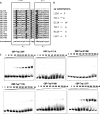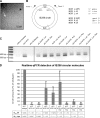Characterization of the transposase encoded by IS256, the prototype of a major family of bacterial insertion sequence elements
- PMID: 20543074
- PMCID: PMC2916423
- DOI: 10.1128/JB.00226-10
Characterization of the transposase encoded by IS256, the prototype of a major family of bacterial insertion sequence elements
Abstract
IS256 is the founding member of the IS256 family of insertion sequence (IS) elements. These elements encode a poorly characterized transposase, which features a conserved DDE catalytic motif and produces circular IS intermediates. Here, we characterized the IS256 transposase as a DNA-binding protein and obtained insight into the subdomain organization and functional properties of this prototype enzyme of IS256 family transposases. Recombinant forms of the transposase were shown to bind specifically to inverted repeats present in the IS256 noncoding regions. A DNA-binding domain was identified in the N-terminal part of the transposase, and a mutagenesis study targeting conserved amino acid residues in this region revealed a putative helix-turn-helix structure as a key element involved in DNA binding. Furthermore, we obtained evidence to suggest that the terminal nucleotides of IS256 are critically involved in IS circularization. Although small deletions at both ends reduced the formation of IS circles, changes at the left-hand IS256 terminus proved to be significantly more detrimental to circle production. Taken together, the data lead us to suggest that the IS256 transposase-mediated circularization reaction preferentially starts with a sequence-specific first-strand cleavage at the left-hand IS terminus.
Figures





Similar articles
-
Transposase-dependent formation of circular IS256 derivatives in Staphylococcus epidermidis and Staphylococcus aureus.J Bacteriol. 2002 Sep;184(17):4709-14. doi: 10.1128/JB.184.17.4709-4714.2002. J Bacteriol. 2002. PMID: 12169594 Free PMC article.
-
DNA-binding activity and subunit interaction of the mariner transposase.Nucleic Acids Res. 2001 Sep 1;29(17):3566-75. doi: 10.1093/nar/29.17.3566. Nucleic Acids Res. 2001. PMID: 11522826 Free PMC article.
-
Defining functional regions of the IS903 transposase.J Mol Biol. 1997 Dec 12;274(4):491-504. doi: 10.1006/jmbi.1997.1410. J Mol Biol. 1997. PMID: 9417930
-
IS1-encoded proteins, InsA and the InsA-B'-InsB transframe protein (transposase): functions deduced from their DNA-binding ability.Adv Biophys. 1995;31:209-22. doi: 10.1016/0065-227x(95)99393-4. Adv Biophys. 1995. PMID: 7625275 Review.
-
Copy-out-Paste-in Transposition of IS911: A Major Transposition Pathway.Microbiol Spectr. 2015 Aug;3(4). doi: 10.1128/microbiolspec.MDNA3-0031-2014. Microbiol Spectr. 2015. PMID: 26350305 Review.
Cited by
-
Transposition of a rice Mutator-like element in the yeast Saccharomyces cerevisiae.Plant Cell. 2015 Jan;27(1):132-48. doi: 10.1105/tpc.114.128488. Epub 2015 Jan 13. Plant Cell. 2015. PMID: 25587002 Free PMC article.
-
Attachment and biofilm forming capabilities of Staphylococcus epidermidis strains isolated from preterm infants.Curr Microbiol. 2013 Dec;67(6):712-7. doi: 10.1007/s00284-013-0425-3. Epub 2013 Jul 30. Curr Microbiol. 2013. PMID: 23896692
-
Draft Genomes of Six Philippine Erwinia mallotivora Isolates: Comparative Genomics and Genome-Wide Analysis of Candidate Secreted Proteins.Curr Microbiol. 2022 Apr 18;79(6):164. doi: 10.1007/s00284-022-02857-x. Curr Microbiol. 2022. PMID: 35435500
-
Insertion sequence-mediated phage resistance contributes to attenuated colonization of cytolytic Enterococcus faecalis variants in the gut.Microbiol Spectr. 2025 Apr 15;13(5):e0330324. doi: 10.1128/spectrum.03303-24. Online ahead of print. Microbiol Spectr. 2025. PMID: 40231830 Free PMC article.
-
Genomics of Clostridium taeniosporum, an organism which forms endospores with ribbon-like appendages.PLoS One. 2018 Jan 2;13(1):e0189673. doi: 10.1371/journal.pone.0189673. eCollection 2018. PLoS One. 2018. PMID: 29293521 Free PMC article.
References
-
- Aravind, L., V. Anantharaman, S. Balaji, M. M. Babu, and L. M. Iyer. 2005. The many faces of the helix-turn-helix domain: transcription regulation and beyond. FEMS Microbiol. Rev. 29:231-262. - PubMed
-
- Byrne, M. E., D. A. Rouch, and R. A. Skurray. 1989. Nucleotide sequence analysis of IS256 from the Staphylococcus aureus gentamicin-tobramycin-kanamycin-resistance transposon Tn4001. Gene 81:361-367. - PubMed
-
- Cafiso, V., T. Bertuccio, M. Santagati, V. Demelio, D. Spina, G. Nicoletti, and S. Stefani. 2007. agr-Genotyping and transcriptional analysis of biofilm-producing Staphylococcus aureus. FEMS Immunol. Med. Microbiol. 51:220-227. - PubMed
Publication types
MeSH terms
Substances
LinkOut - more resources
Full Text Sources

